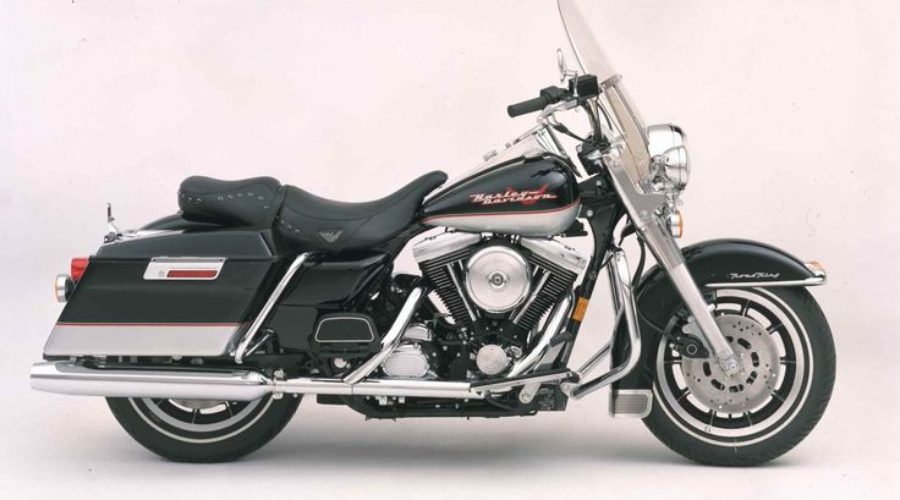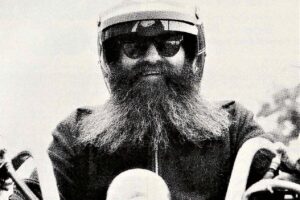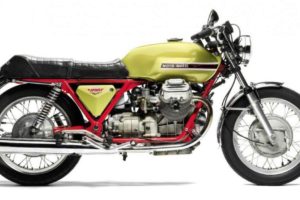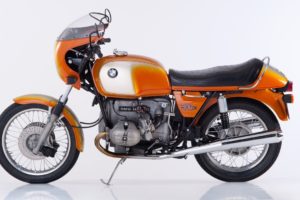1994-1998 Harley-Davidson Road King
Coming over that last hill on the outskirts of town, it seemed like the valley and the road wound on to the mountains in the distance. A cloudless sky, a river running through the sugar cane and macadamias with the big Harley sitting on the road like a pyramid on a day pass.
At last, after an hour of running through city traffic, suburban sprawl and some busy freeway, feeling more like a mobile billboard for a ’50s movie than a guy out for a ride, the Road King was finally in its element. We’d arrived in open country, away from prying eyes. It was time to make out …
A new Harley test? About as exciting as a new McBurger, right? Same stuff, repackaged.
“Concentrate on the differences!” screamed Matho, “Concentrate on the differences!” But readers used to soaking up technological leap frogs from Europe and Japan are going to switch off at the mention of the new elongated dash panel. One wonders if that digital odometer, albeit set in the old speedo, is going to rock a wave of riders more intent on the FZR1000’s new Ohlins forks.
Not bloody likely, but sheer enjoyment rides high in the saddle here. Very high, at least four cm higher than an Electra Glide by the way.

Therein lies the spirit of Harley’s new Road King. It’s enjoyment personified — easy, relaxed and safe motorcycling on something that’s too damned big not to be noticed. Buddy, this is a motorcycle that has small trucks quaking on the side of the road. People follow you on the Road King, even if it is just because they’re trapped in your slipstream.
The 1994 FLHR Road King is another Harley, yes, but to ride it is to acknowledge why Harley sells so many damned bikes. The King feels bloody great. The rider sits tall on the seat, up and over the handlebars, looking down to the speedo. With feet on footboards, knees bent and back straight, the position reminds me of sitting at gran’s kitchen table, making vroom-vroom noises with my cutlery.
So what’s new about the new model? It’s there if you’re prepared to look for it. Basically, though, it’s a stripped down Electra Glide, utilising the same vibration isolating super-strong frame, air suspension and rake/trail geometry (26°/156 mm). In the engine/drivetrain package there’s nothing to separate it from any of the other big-motor Harleys, It’s got a 1340 cc Evolution motor with 8.5:1 compression, five-speed constant mesh transmission and belt final drive.

The Road King (like its brothers) holds over an extra litre of engine oil — 4.4 litres compared to the 3.3 litres of the rest of the big twin range. Like the Ultra and Electra Glides, it also runs a dual-outlet exhaust but the absence of the pannier protection bars that run around the rear of these models means those big beautiful pipes really stick out. That’s a good thing, because they don’t utter much more than a “foot foot” noise anyway …
Hmm, still avoiding the issue of what’s new. The huge engine crash bars, mounted in a way that looks like they’d nearly twist off before bending your frame, sure aren’t new. They, too, are from the Electra. The front guard looks different but that’s only because it’s lost its lower trim, the thing some riders of other makes scoffingly call a ‘bumper bar’. The rear guard features a little innovation that seems a tad useless at first, but could possibly save some fat panel and paint bills over the years. Yes, it’s a low impact-absorbing rubber bounce pad and if you’ve ever rolled back into something more solid than your bike, you’d understand the sense of a feature like this.

New you cry, what’s new? New. New. OK, I’ve already mentioned the digital odometer and the new dash panel. How about the chrome nacelle headlight surround? That’s new, it just looks old. And it’s pure Road King, too: you won’t find that on any of the other Harleys, not until next year anyway.
Along with that nacelle goes a new windscreen, which is actually the same as the one fitted to the Heritage Softail Classic. It’s detachable in less than a minute, thanks to a couple of very sturdy wire clipping mechanisms. Why so easily detachable? Because the Road King also features a split seat. By undoing one screw it’s possible to pull off the pillion seat and convert the bike to a studded leather-saddled solo.
So, and this is no joke, the bike converts from a full-on tourer for two to a ballsout rock’n’roll macho machine in less time than it takes to list all the other changes to the new model. Ahem.
Basically Freddy, the Road King is a stripped Electra Glide with a bit of trimming thrown in. It’s lighter, because it’s stripped, by some 22 kilos (32 less than the stereo equipped Ultra Classic) and presumably that’s why the factory bulletin gives it a tad more ground clearance than its bigger brothers. And none of that, I’m afraid, goes anywhere near explaining the sheer aura of the machine and why it feels so damned good to be out riding the King.

Nope, that remains the intangible. From the minute I threw a leg over the Road King and felt for the starter button it felt good. The new seat is noticeably higher and feels even more so thanks to the lack of fork-mounted fibreglass. You sit up and over the speedo, as I mentioned before, but with feet placed comfortably on the floorboards and a wide set of ‘bars your back is straight and the position feels as comfortable as it does controllable. Everything falls easily to hand and Harley’s lever blades and switchblocks are big blocky jobs with a tad of contour and they work perfectly.
Riders that aren’t used to the sheer bulk of a big motorcycle might feel a little intimidated at first but that soon wears off once you relax and get into it. Like the big Wings, Kwaka Sixes and the other heavyweights of motorcycledom, the Road King only needs to roll to shed its weight.
Also very confidence inspiring are the twin disc brakes up front that, in conjunction with the air suspension, work bloody brilliantly! They’ve still got the traditional Harley heavy feel, but you get the idea that if they did need locking it’s only one fistful away, not the two or more required on older big twins.

Similarly, Harley perfected its back brake some four years ago and not much has happened since except styling changes. It’ll lock, but it takes some pressure. The thing about a slow steering, heavy bike with sixteen inch tyres back and front is that you don’t want brakes that lock, you want them to be progressive. Otherwise, the big dump is as easy as a bit of overzealous braking. I’ve only slid down the road once on a Harley full dresser, but once is definitely enough!
Right. This air suspension. The Road King shares the same system fitted to its heavier brothers, but our test bike seemed far more sensitive to pressure changes. The suspension is linked crossways, so you’ve got two air valves, one for the front forks and one for the rear units. Maximum pressure allowable up front is 25 psi and they recommend 15 for most work.
With no pressure it felt slushy and 25 was too rock-like to even be considered sporting. At the rear the factory tells us 35 psi is the maximum allowable and they recommend somewhere between zero and 10 psi for normal loads and riding conditions. Obviously the 35 is for two huge people carrying a load of gold bars to the bank because 10 psi felt firm enough for not-so-light me and a mate. More importantly, even after a stretch of pretty tortuous back road in the Kyogle shire, suspension fade wasn’t noticeable.

Harley’s new generation fibreglass panniers are beautifully finished and even more practical than ever with the addition of fly-off straps on the lids — so they don’t. Without those chrome rails they seem to be bigger but a measure up proved that this was just another hopeful idea. They’re the same.
There’s a new fuel tank though, a one piece 18.95 litre unit, same as … yeah, you guessed it. If there was something that could be improved on the Road King, or the Electra or Ultra for that matter, it’s the fuel capacity. With a test average on tour of around 6 litres/100 km, the King’s good for a push at a little over 300 kilometres. For a bike that’s never going to feel uncomfortable, that’s not much freight between stops.
Stops? Yeah, plenty, but not for comfort. The Road King is so enjoyable to ride that the overwhelming feeling was to just keep on riding, to stop wherever possible, to dilly dally around, to just stay out there on the road, playing around. Making out. Hey, long live the King, she’s a real Princess!
By John Rooth. Two Wheels, November 1994
Second Opinion
Here we have a new Harley model that has been sold out worldwide, even before the 4000-unit model run left the factory. Sold off pictures in brochures. Just how has Harley managed this with what is basically a simple revamp? Because they have made the FLH that Hog riders have wanted for years.
Strip the Ultra Classic but keep the bits that really work, such as air suspension, the roomy touring frame and ultra-reliable 80-cubic inch Evo motor. Wrap some retro panniers, mufflers and a perspex windscreen around that big hunk of a motor. Bolt on a set of headlights that tell the world it’s about to be passed by a piece of Milwaukee magic. Top it off with a ’50s paint job and hey presto! You’ve got yourself a bitchin’ bike, buddy.
It’s hard to understand why anyone would want to pay so much for out-dated technology, but as soon as I sling a leg over one, I’m a goner. So much so that I now know that the day I finally do the circuit of Australia I’ve promised myself since 1979, I will do it on a Harley and, hopefully, a Road King.
It is comfortable enough, tough enough and simple to maintain.
Best of all, it is cool enough.
Because, you see, in the 1990s, the Harley world is as radical in its own way as the frenzied wasteland of the Honda Fireblade or ZZR1100 Kawasaki. But instead of high revs, smoking rubber and torn kneesliders, you have a V-twin engine beat that soothes away life’s stresses and gives you time to drink in the sights and smells of motorcycling.
Some fellow riders may scoff, many will salute, but it doesn’t matter to you because you are … King of the Road
By Hamish Cooper. Two Wheels, November 1994

The Wizard of Id: 1998 FLHRI Road King
My motorcycling id is still twitching after its biggest hard-on in a long time. So draining was the relief that my impulsive side still hasn’t recovered after a couple of weeks. Even the ego went along for the ride and came back with a new lease on life. You see, I’ve just been across the Nullarbor on a Harley-Davidson Road King.
Without a shadow of doubt, the Road King was central to the thrill. I’ve ridden other Harleys over the years and tried a couple of others on this trip, but none compared with the King. It’s long, wide and comfortable, built to eat miles as an ideal travelling companion. The deep rumble (yeah, so I cheated on the accessory pipes), the lumpy vibration, the wind-cheating screen and the all-day-long performance cut straight to my heart and carried it right across this vast continent from Melbourne to Perth.

I’ve always liked the style of Harley’s stripped dresser (an oxymoron if ever there was one). I’ve got a picture on my wall of the Panhead Duo Glide — the forerunner, albeit not quite the first, of the King. The long, wide, bulky look is powerful with a purposefulness the full-dressed models lack. The lines are smoother and more integrated than on the other 1340s except perhaps the Heritage Softail and Fat Boy.
The Road King invites you to sit back and relax at anywhere from 80km/h up and enjoy the view. What’s the rush when you’re comfortable, content and seeing beautiful country? It’s good for a trip up the Hume, a strut along the boulevarde or a cruise through the back blocks.
Part of the reason the Road King feels so good is it looks so good. When the stripper model was the Electra Glide Sport, it was ugly because of the big, boofy, plastic instrument nacelle on the headlight. As the Road King, with few changes other than the cleaner styling, it’s absolutely stunning. The angled panniers, big crash bars, oldfashioned screen, shrouded forks, skirted guards — the lot — make it one of the best looking bikes on the road.
And you can say what you like about the crudeness of Harley mechanicals, but the cobby separate-unit engine design is far more interesting and impressive aesthetically than the bland Japanese V twins. In fact, up close the Harley is much nicer than most of the comparatively sterile Japanese bikes which have sensible but more boring designs for things like levers, footboards, covers, and so on.

The Road King is built to be stripped even further by the owner. The screen comes off in seconds, the panniers unbolt and the pillion seat detaches. The result is a sportier profile which is very different from the tourer it starts out as.
The Road King is the latest Harley available with fuel injection if you opt to pay the modest premium for the electronic wizardry. Starting is a breeze — a one-touch button and an automatic fast idle circuit. The EFI system allows the big twin to work better on lower grade fuel, improves fuel efficiency and adds about 10 per cent more torque through most of the rev range, although the EFI model actually has less maximum torque — 95Nm against 99 — and makes it happen at 3500 rpm instead of 3000, but this doesn’t detract from the fun of humming along at low revs, or belting away from the lights on the low-end pull of the machine. The throttle response is certainly better than I remember from carbed Harleys.
H-D is not into publishing power figures, nor was a dyno handy for this touring test, but the EFI model feels stronger than a carburated version. This doesn’t mean much, really, when you’re talking less than 40kW outright anyway. It’s the long-stroke, 1340cc twin’s torque which matters and makes the difference.
On a good day with a bit of a tailwind the Road King sees about 170km/h, even with the screen jamming the air in front. But top speed varies greatly under different conditions, with low grade fuel, gusting side winds and a big load making it breathless around 120km/h. The point isn’t so much the speeds as the relative inefficiency of the monster motor when the crunch comes.

To go any faster the big twin needs to breathe. The green King in the pictures is blessed with a gorgeous set of genuine Harley fishtail pipes which look horn and endow it with a deep basso voice that’s not offensive. They also let gas flow more easily and so this Road King accelerates quicker than the stock purple and red bike here. There’s lots more low-end and midrange grunt, so you can really feel it punch from 80km/h when you crack the throttle. The stock one is firm but gentle when it accelerates.
But they both hit the same top speed. A less restrictive air intake is needed to overcome the top end hurdle.
The 1340, even with EFI, feels better on premium grade petrol, too, with less pinging under load. Basic unleaded is okay if there’s no choice, but the higher the octane the happier the Hog.
The big twins are, of course, still driven by a primary chain to a separate-unit gearbox. Looks great, as I’ve said, but ultimately it’s a pain in the arse for longterm ownership compared to unitconstruction engines with gear primaries. It also adds another oil reservoir which needs checking and changing at intervals.
The clutch is good, and takes up strongly despite the massive torque you can dump through it from a standing start. The gearbox action is pretty ordinary, although no worse than some Japanese big twins. The trick is to always be deliberate, use the heel-and-toe lever firmly and learn the conditions in which the ‘box likes to shift up or down. For example, it’s usually better to shift up without letting the revs drop.
The powerplant is rubber-mounted in the heavy steel frame. At idle the bike shakes and shimmies as the big pistons lope up and down their cylinders. On the move, depending on how high you rev it, the bike either pulses or is nearly smooth, always feeling pleasant and never uncomfortable like the high-pitched buzz of fours can be, or like the violent vibration at speed of the solid-mounted Softail design.

When you’re on the road you hunch slightly forward to the handlebars. The footboards are large and adjustable, the seat wide and plush and the screen protective beyond what its unshaped appearance would suggest, although its effectiveness against buffetting is entirely dependent on wind conditions.
The hunched position is dictated by the wide, low handlebars, which many riders swap for touring ‘bars like the Electra Glide’s. I enjoy the stock bars most of the time but they do cause aching shoulderblades on long days and will be a real problem for short riders. This ride position makes more sense when you take off the screen and face a much bigger blast of air.
At times you notice plenty of warmth from the engine on your thighs, and pillions feel it on their feet.
The noise you hear from the seat is pathetic on a stock-piped Harley, unlike some Japanese cruisers with their ‘tuned’ exhausts. H-D needs to start designing quiet pipes with a nice note to enjoy, especially now the company has registered the 45 degree V-twin’s “potato potato” beat.
The Road King has easy handling in all conditions. This is one of its secrets, putting it high on the list of desirable touring bikes and giving it surprising versatility. It rides the straights with unfussed character, corners with verve, is manoeuvrable above jogging pace (but clumsy below it) and also works remarkably well in the dirt and on wet roads.

It steers wonderfully, but nobody wants to believe it’s so much fun to pitch this 315kg lump of lard into a sweeping bend and give it the berries. Its cornering clearance isn’t too bad, either. Take a smooth line and a classic style — brake, turn, apex, accelerate — and it’s a ball. The low centre of gravity and wide ‘bars aid the equation.
The suspension has pretty good spring rates and hints of damping. It gets overtaxed on rough roads as the speed increases, but is better than some of the Japanese cruisers, the new Kawasaki Vulcan Classic in particular. Stop quickly and the forks dive deeply then spring back and pogo thanks to the piss-poor damping. Better suspension could definitely be fitted, but the stock set-up gives a comfortable touring ride which suits the King’s purpose.
The braking system is a weak set-up of single-piston calipers on three discs. A new front master cylinder reduces the effort required at the lever, but adequate is a generous description which holds under normal circumstances. They’ll fade if used hard several times and, more importantly, they don’t stop this bulky bike quickly enough in an emergency. The fact the Road King pulls up straight and steady is little compensation.
That huge headlight works really well. The tank-mounted warning lights, however, are out of your direct line of sight and can be hard to see in bright sun. The tank-mounted speedo takes a bit longer to read than conventionally-placed ones. The switchgear for 1996 Harleys has been improved and rounded off more stylishly, but the bikes still feature the dicky self-cancelling blinkers which never stay on long enough and are both activated and cancelled by the same buttons, a stupid system which makes you spend inordinate amounts of time looking down at the lights on the tank, instead of at the road ahead, to see if you’re indicating or not. The loud horn’s button has been moved inboard on the left block to a better position.

The ignition key doesn’t stay in the ignition, which is dumb. The key just locks and unlocks the ignition and the steering lock. You use it, then pocket it or lose it. The barrel-type locks are harder to break than conventional blade-key locks.
The panniers have top-opening lids which seal very well, if not quite perfectly. You can’t remove the boxes to carry into your motel room but they lock securely. Special bags can be bought to fit inside so you can easily carry your gear away with you at night.
The finish is very good, surviving the odyssey across the country without damage. The chrome is great and the paint is hard, deep and lustrous. Modern Harleys are still not as reliable as many other brands, but they are dependable and long lived, and will have parts available for decades to come.
Prices start at $24,500 for a Road King. Add a grand for fuel injection, $500 for two-tone paint. It’s not a cheap machine, but resale value for Road Kings is proving to be very good. Personally, I wouldn’t be looking at selling one soon enough to capitalise on resale windfalls, anyway.
The Road King encourages you to ride as often as you can, to anywhere you want. It’s a feel-good machine which calls you to hit the road — to Cocklebiddy or the local cafe. It makes no demands, but offers uncounted rewards. To me, it captures the essence of the Harley-Davidson experience better than any other Harley and would offer a serious challenge to any other cruiser or tourer you’d line it up against.
No wonder they call it the Road King.
By Mick Matheson. Two Wheels, December 1996


These 1994-1998 Evo-powered Road Kings are among the most collectable Harleys. Guido from AllMoto Motorcycle Investor takes a close look here at how the Road King evolved, what to look for if you’re thinking about putting one in your shed, and what you can expect to pay.




